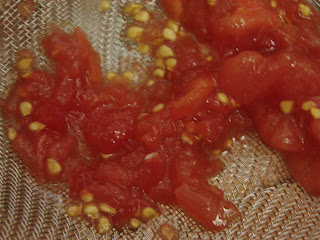Find a branch on your tomato plant with flowers that haven't budded yet. The reason for this is that all tomatoes are self pollinating but a few varieties can be cross pollinated by insects and wind. Cover this branch with cheesecloth or a light polyester fiber. Remove this cover when fruits begin to develop, tag your stem so you will know which tomatoes you need to pick for your seeds.
I don't do this for one simple reason, my kids would yank the cloth off and it would end up with a torn branch. It doesn't matter to me (really) if my tomatoes are cross pollinated. But if you want to make sure you have a pure harvest of the tomatoes and not a cross cover them .
Now it's time to pick your tomato and save it's seeds, depending on your type of tomato you may need to pick more than one.
Now it's time to cut the tomato in half. Do it across the center, not up and down.
Scoop out the pulp sends
Place them in a dish or jar. Pour a little water in to jar or dish, At least to cover the mixture.
Cover the dish with plastic wrap with some slits cut through the top.
Set the dish or jars away from anywhere you'd be walking. This will start to smell real bad in just a day or two.Let it sit to ferment for 3-5 days till it starts getting moldy.
After it is covered in mold, carefully scoop the mold out and pour more water into the dish or jar. The good seeds will sink to the bottom. Scoop everything else out and pour remaining into a strainer.
Run under water until the pulp is gone and all you have left is the seeds. Set on a paper towel and rub any gel that is still around seeds off. Set out to sit for another 3 days.
Now that you have your seeds all dried, label them in a small packet for easy usage next year!






















